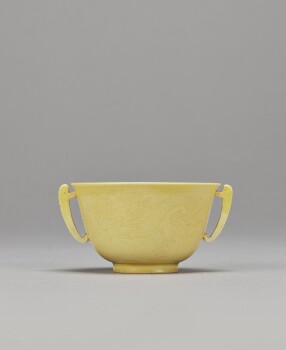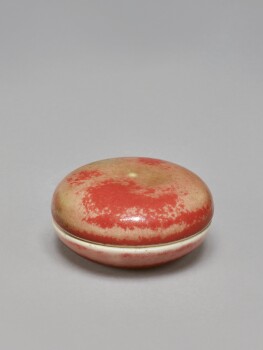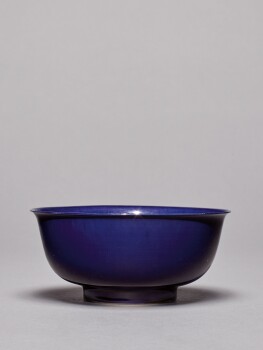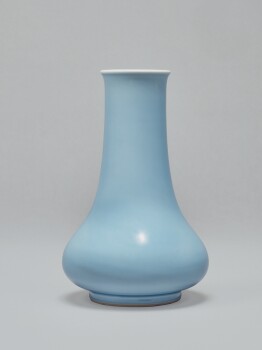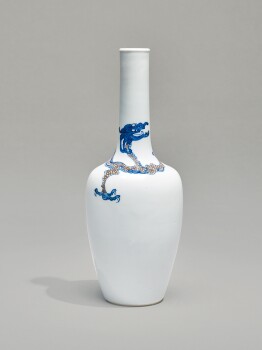T his September, Sotheby’s will offer a group of imperial Kangxi period (1662-1722) porcelain assembled by a private collector who started acquiring Chinese art in the 1970s. Many of the works were formerly owned by esteemed and influential collectors of Chinese art such as E.T. Chow, H.M. Knight, T.Y. Chao and Francis and Brodie Lodge. Highlights include an exceptional underglaze-red and famille-verte ‘rose’ vase, a rare celadon-glazed ‘dragon’ amphora vase, and a discerning selection of peachbloom-glazed vessels for the scholar’s table.
Featured Highlights

What’s in a name? Chinese glaze terminology
Chinese potters were masters of glaze technology and their creations were widely admired by domestic and international audiences alike. Over time, connoisseurs developed specialized nomenclature to describe the qualities of specific glaze types, and many of these terms continue to be used today. Among the most celebrated glazes are the so-called ‘peachbloom’, ‘clair-de-lune’, ‘Langyao’, and ‘sacrificial blue’ glazes, all of which appear in this exquisite private collection of porcelains from the Kangxi period. Below is a brief introduction to the history of each of these terms and their meanings.
Formal Elegance: Kangxi Peachbloom-glazed vessels
With its wide range of tones and variegated effects, the peachbloom glaze ranks among the most important innovations developed by the imperial kiln factory in Jingdezhen, Jiangxi province. Peachbloom is special among Qing dynasty glazes as it deliberately exploits the different decorative effects that the elusive copper pigment produced during firing. Copper pigment had been largely abandoned after the Xuande reign (r. 1426-35) because it was notoriously difficult to fire and often produced uneven and unsatisfactory results. The appointment of Zang Yingxuan as supervisor of the imperial kilns and his arrival at Jingdezhen on the 20th year of Kangxi’s reign, corresponding to 1681, initiated a new era of high-quality production. Imperial peachbloom wares were only made during the Kangxi period but in several finely potted elegant forms, demonstrating the technical artistry of Qing potters. Explore and discover the famous forms below.

Brush Washer (Tangluo xi)

Known by the descriptive term tangluo xi, this brushwasher represents one of the most well-known forms among peachbloom wares. However, this piece is particularly special for the additional wen (italics) character inscribed on the foot. Wen signifies culture and education, and is therefore highly appropriate for this type of vessel.
Beehive Waterpot (Taibai zun)

Waterpots of this characteristic form are known as taibai zun, after the Tang dynasty (618-907) poet Li Taibai (701-762). A notorious drinker, he is often depicted leaning against a wine jar of this form. While this form is commonly described as a waterpot, its intended use is difficult to identify. It is imagined that vessels of this type were filled with water to allow a painter to dip their brush and then shape it on the neck. However, Chinese painters typically dip their brush directly into the ink, previously prepared by grinding an ink cake with a few drops of water.
Amphora Vase (Liuye ping)

Vases of this form are known as liuye ping (willow-leaf bottles), in reference to one of Guanyin’s attributes, a branch of willow, or alluding to the resemblance of its form to a slender willow leaf. The form of this vase is particularly elegant and would have required a stand to be securely displayed as its narrow foot, recessed base and elongated form made it unstable. The potter cleverly designed the piece with a high foot which has been left unglazed to accommodate the stand.
Chrysanthemum Vase (Juban ping)

Known as juban ping, ‘chrysanthemum petal vase’, this piece is remarkable for its pleasing, well-balanced form and delicate rose-pink glaze. The remarkable quality and variety of new forms created during the Kangxi reign at the imperial kilns in Jingdezhen could hardly be better illustrated than by the present vase. The fine potting and striking mottled glazes display the technological and artistic advances made at Jingdezhen in this period.
Seal Paste Box (Yinni Gaihe)

Small boxes for storing seal paste were often made in the preceding Ming dynasty from organic materials; standing as symbols of simplicity and a life lived in tune with nature, concepts at the center of Daoist and Neo-Confucian philosophy. The peachbloom glaze, especially cherished because of its deceptive simplicity and unpredictability, provided scholar-officials with an attractive porcelain alternative.
Illustrious Collectors of Kangxi Porcelain
Kangxi period porcelains have attracted the most discerning connoisseurs and collectors for over three centuries. As a result, some of the finest pieces can be traced to illustrious owners, and a fuller picture can be painted of their circulation in these elite circles. Numerous porcelains in the present private collection were previously enjoyed by renowned collectors of the past two centuries, whose deep expertise and admiration of Chinese porcelains advanced the study, appreciation, and preservation of these treasures. Below are brief biographies of some of the significant previous owners of porcelains in the present sale.
- Henry M. Knight (d. 1971)
- T. Y. Chao (1912-1999)
- Edward T. Chow (1910-1980)
- Dr. Herman Lindberg
- Enid and Francis Brodie (1880-1967) Lodge
- Brayton Ives (1840-1914)
-
 Henry M. Knight (d. 1971)Henry M. Knight was a discerning collector who, from 1930 until his death in 1971, assembled a major collection of Chinese ceramics and works of art, focusing mainly on Ming (1368-1644) and Qing (1644-1911) porcelains, buying largely from Bluett & Sons, London. Roger Bluett wrote about him: “Henry Knight, who built up perhaps the best collection of eighteenth-century porcelains in Europe as well as magnificent early pieces, was fond of telling how it was my late father who told him to buy ‘Chinese taste’ porcelains. Their time would come, my father used to say, and how right he was.”
Henry M. Knight (d. 1971)Henry M. Knight was a discerning collector who, from 1930 until his death in 1971, assembled a major collection of Chinese ceramics and works of art, focusing mainly on Ming (1368-1644) and Qing (1644-1911) porcelains, buying largely from Bluett & Sons, London. Roger Bluett wrote about him: “Henry Knight, who built up perhaps the best collection of eighteenth-century porcelains in Europe as well as magnificent early pieces, was fond of telling how it was my late father who told him to buy ‘Chinese taste’ porcelains. Their time would come, my father used to say, and how right he was.” -
 T. Y. Chao (1912-1999)Tsao Yee Chao was an entrepreneur born and raised in Shanghai, who practiced law until the Japanese occupation in the 1930s. At that point, he switched to the import/export business, and entered into his first shipping venture, which transported coal along the Chinese coast. In 1948 he moved with his family to Hong Kong, where he founded two shipping companies, the second of which was the highly successful Wah Kwong Shipping and Investment Company. Over 40 years, he and his wife assembled an exceptional collection of about 400 Chinese porcelains and jade carvings, a selection of which were auctioned in two landmark single-owner sales at Sotheby’s Hong Kong in November 1986 and May 1987.
T. Y. Chao (1912-1999)Tsao Yee Chao was an entrepreneur born and raised in Shanghai, who practiced law until the Japanese occupation in the 1930s. At that point, he switched to the import/export business, and entered into his first shipping venture, which transported coal along the Chinese coast. In 1948 he moved with his family to Hong Kong, where he founded two shipping companies, the second of which was the highly successful Wah Kwong Shipping and Investment Company. Over 40 years, he and his wife assembled an exceptional collection of about 400 Chinese porcelains and jade carvings, a selection of which were auctioned in two landmark single-owner sales at Sotheby’s Hong Kong in November 1986 and May 1987. -
 Edward T. Chow (1910-1980)Edward T. Chow was a highly influential 20th-century dealer-collector. At age thirteen, he moved from Yangzhou to Shanghai to study Chinese art with the dealer Zhu Heting. During the 1935-36 Royal Academy International Exhibition of Chinese Art in London, Chow met esteemed Chinese art collector George Eumofopoulos, and went on to develop relationships with major collectors including Sir Percival David, King Gustaf Adolf of Sweden, Eiichi Ataka, J.M. Hu, Barbara Hutton and the Meiyintang Collection. In 1980 and 1981, Chow's collection sold at Sotheby’s Hong Kong and London, where it achieved sensational results and precipitated a new era of exceptional prices for Chinese art.
Edward T. Chow (1910-1980)Edward T. Chow was a highly influential 20th-century dealer-collector. At age thirteen, he moved from Yangzhou to Shanghai to study Chinese art with the dealer Zhu Heting. During the 1935-36 Royal Academy International Exhibition of Chinese Art in London, Chow met esteemed Chinese art collector George Eumofopoulos, and went on to develop relationships with major collectors including Sir Percival David, King Gustaf Adolf of Sweden, Eiichi Ataka, J.M. Hu, Barbara Hutton and the Meiyintang Collection. In 1980 and 1981, Chow's collection sold at Sotheby’s Hong Kong and London, where it achieved sensational results and precipitated a new era of exceptional prices for Chinese art. -
 Dr. Herman LindbergDr. Herman Lindberg was a physician and the son of the well-known pediatrician and professor, Dr. Gustaf Lindberg (1887-1961). The father and son amassed a notable collection of Chinese porcelains and antiquities, as well as contemporary paintings. Together with the Swedish King Gustaf VI Adolf, Carl Kempe, and other collectors, they founded the Swedish Oriental Ceramic Society, “Kinaklubben”, in 1929. Herman Lindberg donated part of his collection to the Museum of Far Eastern Antiquities, Stockholm in 1960.
Dr. Herman LindbergDr. Herman Lindberg was a physician and the son of the well-known pediatrician and professor, Dr. Gustaf Lindberg (1887-1961). The father and son amassed a notable collection of Chinese porcelains and antiquities, as well as contemporary paintings. Together with the Swedish King Gustaf VI Adolf, Carl Kempe, and other collectors, they founded the Swedish Oriental Ceramic Society, “Kinaklubben”, in 1929. Herman Lindberg donated part of his collection to the Museum of Far Eastern Antiquities, Stockholm in 1960. -
 Enid and Francis Brodie (1880-1967) LodgeFrancis Brodie Lodge was the second son of the scientist Sir Oliver Lodge. After studying at Eastbourne College, Francis worked for a shipping company before starting Lodge Brothers (later, Lodge Plugs) with his brother, a highly successful company which manufactured spark plugs based on their father’s research. After marrying Enid, the couple developed a fascination with Chinese porcelain, even visiting the Royal Academy Exhibition of Chinese porcelains (1935-36) an alleged 24 times. They became early members and strong supporters of the Oriental Ceramic Society, and contributed to many of the Society’s exhibitions. Their collection comprised ceramics from the Tang (618-907), Song (960-1279), Ming (1368-1644) and Qing dynasties as well as archaic bronzes.
Enid and Francis Brodie (1880-1967) LodgeFrancis Brodie Lodge was the second son of the scientist Sir Oliver Lodge. After studying at Eastbourne College, Francis worked for a shipping company before starting Lodge Brothers (later, Lodge Plugs) with his brother, a highly successful company which manufactured spark plugs based on their father’s research. After marrying Enid, the couple developed a fascination with Chinese porcelain, even visiting the Royal Academy Exhibition of Chinese porcelains (1935-36) an alleged 24 times. They became early members and strong supporters of the Oriental Ceramic Society, and contributed to many of the Society’s exhibitions. Their collection comprised ceramics from the Tang (618-907), Song (960-1279), Ming (1368-1644) and Qing dynasties as well as archaic bronzes. -
 Brayton Ives (1840-1914)Brayton Ives (1840-1914) was a Civil War general and president of the Northern Pacific Railway and the New York Stock Exchange. Ives was an avid collector of rare books and art, including Chinese porcelain. His impressive collection was sold by the American Art Association in 1891 and 1915, with the latter sale so immense that a "De Luxe" edition of the catalogue was produced.
Brayton Ives (1840-1914)Brayton Ives (1840-1914) was a Civil War general and president of the Northern Pacific Railway and the New York Stock Exchange. Ives was an avid collector of rare books and art, including Chinese porcelain. His impressive collection was sold by the American Art Association in 1891 and 1915, with the latter sale so immense that a "De Luxe" edition of the catalogue was produced.
















